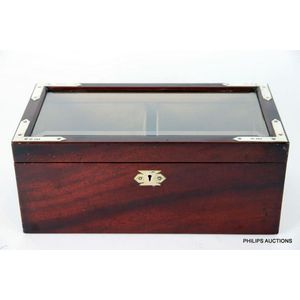Sterling Silver Smokers Cabinet with Glass Top and Compartments
You must be a subscriber, and be logged in to view price and dealer details.
Subscribe Now to view actual auction price for this item
When you subscribe, you have the option of setting the currency in which to display prices to $Au, $US, $NZ or Stg.
- Cartouche - An ornamental panel in the form of of a shield, oval or rectangular scroll with curling edges. It may be carved into the back of a chair or the top of a sideboard, or present on a piece of silver or jewellery, and contain the initials of the original owner, heraldic symbols, or some other inscription, such as the details of a presentation.
In ceramics the term defines the central area of a vase or similar with a decorative border in one of the shapes above, into which a decorative scene or figures have been painted. - Sterling Silver - Sterling silver is a mixture of 92.5% pure silver and 7.5% of another metal, usually copper. Fine silver is 99.9% pure silver, and is relatively soft and the addition of the very small amount of copper gives the metal enough strength and hardness to be worked into jewellery, decorative and household objects.
- Bevel / Chamfer - In furniture making, a chamfered corner refers to a technique used to create a smooth, angled edge on the corner of a piece of furniture. This is typically done by cutting away a small portion of the corner at an angle, typically 45 degrees, creating a diagonal edge, rather than a sharp 90-degree angle. This technique can be used on various parts of a piece of furniture such as table legs, drawer fronts, or door frames. Chamfering can add visual interest to a piece and can help to soften the overall look of a piece of furniture. It is often used in conjunction with other techniques, such as rounding edges or using contrasting wood species to create a more elegant, sophisticated look. Chamfering is a simple way to add a touch of elegance to a piece of furniture and it is a common technique used by furniture makers.
This item has been included into following indexes:
Visually similar items

A Victorian mahogany writing box, 19th century, the hinged box simply adorned with white metal stringing and mother-of-pearl button embellishments and a conforming escutcheon, the interior with paper lining. Height 10.5 cm. Width 25.5 cm. Depth 17.5 cm

A Victorian rosewood lady's travelling compendium with fitted interior.

A Victorian rosewood writing box, 19th century, the rectangular box with a mother-of-pearl cartouche to the lid and a matching escutcheon, with white metal stringing and paper lined to the interior. Height 14 cm. Width 35.5 cm. Depth 24 cm

George III Sheraton inlaid mahogany secretaire with a well fitted interior, circa 1800, with key, unusual interior fitted with indexed compartments, gilt tooled leather inlay, 113.5 cm high, 130 cm long, 52.5 cm deep
